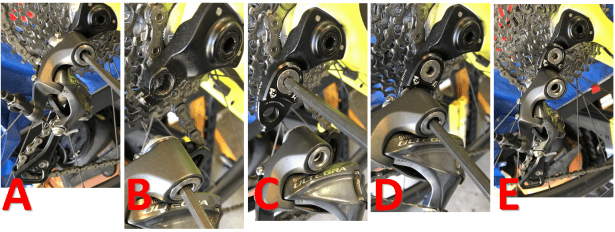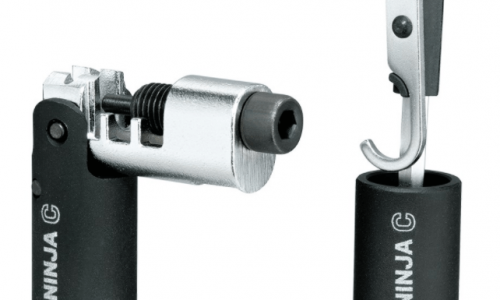RoadLink Rear Derailleur Hanger Review
-
Total rating
Summary
Perfect solution for those wanting a cost-effective solution for the sweet-spot in gearing. 11-32T, 11-34T, 11-36T, 11-40T
Price: $ (view here)
Source: Bike Shops, websites
Features: 10 or 11-speed supported, Easy installation, solution for 11-36T and 11-40T.
Pros
- Solution for gearing in-between ROAD and MTB – the sweet-spot in gearing
- Simple design that really works!
- 5-minute install
- 6061 Aluminum + SS Bolt
- Lightweight 17g (0.6 oz.)
- Manufactured in USA
Cons
- Lots of interdependencies when it comes to gearing. There can be some confusion as to what will work with what. For a list of these caveats, please see the list at the end of the article.
User Review
( votes)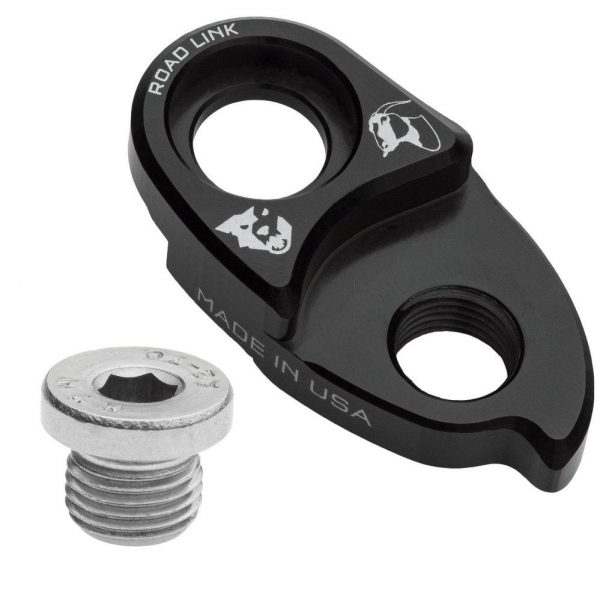
WOLFTOOTH COMPONENTS ROADLINK
REAR DERAILLEUR HANGER EXTENSION
aka how to run a wider-range of mountain bike gearing on a road bike.
SPINNING IS WINNING
How to spin more efficiently is a function of (a) smaller gear inches and (b) high cadence workouts.
I recently heard one of Lance Armstrong’s Stages podcasts (https://www.youtube.com/watch?v=HLdNQgNzhRE) where Lance said “Chris Froome’s gearing up le Mont du Chat [9.2% average grade for 13.5km or 8.4 miles] was 38T in front and 32T in the back. That’s like mountain bike gearing. If you would have rolled up with 38/32 in 1974, the last time they did this in the Tour de France, they would have laughed you right out of the peloton.”
To prove this, look at the following video (https://www.youtube.com/watch?v=qKpyidQ7nWA) which shows what happens if you spin even faster than Lance Armstrong up Mont Ventoux. This video pits Lance vs Pantani at the 2000 Tour de France and Chris Froome against Quintana at the 2013 Tour de France. Ultimately it was Lance & Pantani against Chris Froome.
Chris Froome beat Lance and Pantani by 1:51 – that’s almost 2 minutes! Watch the Wattage and Heart Rate of Chris Froome. Anything under 400W and his heart rate drops to 157, over 400 watts it goes up to 158 and at the top at 500W he is at 159! Now that’s efficient gearing and efficient spinning.
ME TOO
I too was in search for more gearing. I recently purchased a Giant TCR Advanced disc brake bike and wanted to turn it into my “mountain bike.”
Over the past 2 years, I’ve been doing a lot of spinning drills, working on more efficient pedaling. Now, during any given ride, my average cadence is 102-105. Couple this with finding harder hills (15%+ grade) for doing intervals and I’m looking for more than an 11-28 that came with this bike. I kept the 172.5mm Ultegra 6800 crankset, but changed out the 50/34 for ROTOR’s 52/34 elliptical Q-Rings. Note, the 52 elliptical is a ‘virtual’ 55 round chainring.
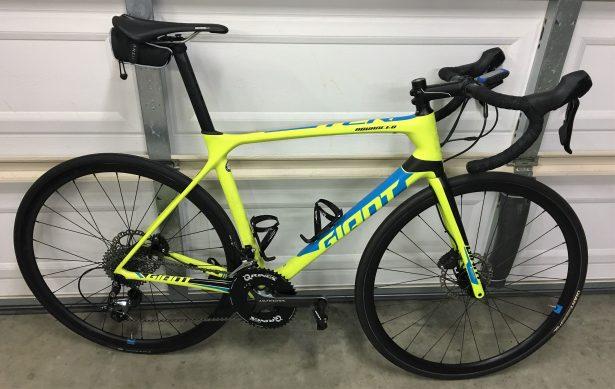
So, downloading several Shimano Tech documents, summarized in table below, I realized that with the stock Ultegra RD-6800-SS short cage rear derailleur, I was limited to an 11-28T cassette. Further research showed that if I swapped out the RD-6800-SS for a RD-6800-GS, its longer cage could support an 11-32T.
But, what if I wanted to go larger than a 32T? The next step up would be 34T. For this, I would need a more expensive RD-8000 ($54 vs $95) plus a more expensive Shimano CS-HG8000-11 cassette which gives me 11-34T.
Now, what if I want to go even larger? Both the SRAM PG-1170 and the PG-1130 cassettes are offered in an 11-36T (11,12,13,15,17,19,22,25,28,32,36). Looks like the best option, but there is a problem with the RD-6800-GS supporting this.
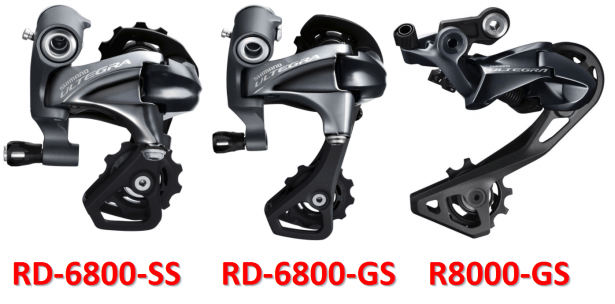
- RD-6800-SS : SHORTEST ‘ROAD’ CAGE
- RD-6800-GS : LONGER ‘ROAD’ CAGE
- R8000 -GS : LONGEST ‘ROAD’ CAGE
BUT FIRST, IT’S ALL ABOUT CAPACITY
PART 1
As mentioned, the RoadLink moves Shimano 10 and 11 speed rear derailleurs to an optimal position for wide range cassettes. What the RoadLink does NOT do is expand your derailleurs capacity.
So, what is [total] capacity? Total capacity is a function of the derailleur mechanics and is how much chain slack the derailleur cage can absorb measured in number of teeth. These are manufacturers recommended ‘safe’ numbers that won’t get you in trouble as to approach the extreme limits of front and rear gear combinations – i.e., big chainring with big-cassette cog (aka big-big), or small-chainring with small cassette cog (aka small-small). Sure, you can go with more teeth, but you risk possible damage to your drivetrain. In other words, derailleur capacity is a specified number that the drivetrain companies (Shimano, SRAM, Campagnolo, FSA, ROTOR, etc.) publish as not to be exceeded.
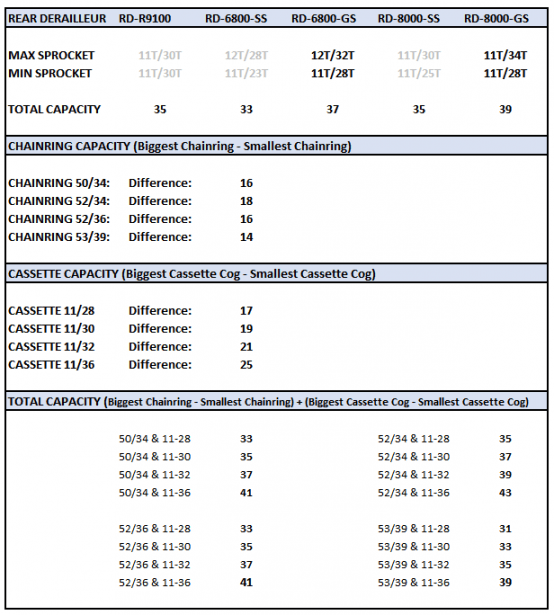
Note: the gearing for the bike pictured above is 52/34 with an 11-36 cassette – which is beyond the recommended total capacity for an RD-6800-GS. This is where you can get into trouble. The 2 potential problems you can get into are;
• Small/Small – there can be too much chain so that the lower pulley ends up above the upper pulley which causes the chain to rub against itself.
• Big/Big – there can be not enough chain so that the rear derailleur can be ripped off the hanger or the hanger ripped off the frame. This is especially true with a Di2 system that has strong motors doing the shifting for you.
HOW TO CALCULATE CAPACITY
You can calculate the capacity using the following formula:
(Biggest Chainring – Smallest Chainring) + (Biggest Cassette Cog – Smallest Cassette Cog)
Equating the photo to the table, the recommended maximum capacity for a RD-6800-GS derailleur is 37T. Again, 37 is the magic number. The bicycle pictured above is setup with a 52/34 & 11/36 cassette which equates to a 43T capacity. 43T exceeds Shimano’s recommended 37T maximum, but, as you can see, using the RoadLink, this bike runs perfectly fine exceeding the maximum by 6T.
Disclaimer – exceeding your derailleurs total capacity is not something that we or Wolf Tooth can recommend, but our testing did show that the actual capacity is significantly higher, over 15% higher, in our case, than the manufactures specification.
PART 2
As mentioned above, what the RoadLink does NOT do is expand your derailleurs capacity. This is where some of the confusion comes from. Speaking to the engineers at Wolf Tooth Components, they said one of the most common asked questions is “can I run a bigger gear?” The answer is yes, as long as you don’t exceed the total capacity. For example, if you are running a RD-6800-SS rear derailleur, what cassettes can you use? From the table above, the capacity of the RD-6800-SS is 33T. If you are using either a 50/34 or a 52/36 the teeth difference is 16T.
Total Capacity = (Biggest Chainring – Smallest Chainring) + (Biggest Cassette Cog – Smallest Cassette Cog),
where Total Capacity = 33T and Big Chainring – Small Chainring = 16T
Rearranging the formula to solve for cassette;
(Big Cog – Small Cog) = Total Capacity – (Big Chainring – Small Chainring), or
(Big Cog – Small Cog) = 33T – 16T, or 17T
What this means is that you can have a maximum difference between the small cog and big cog of 17T.
Without a RoadLink, you are limited to a 28T max size cog.
With a RoadLink, you can go to a 40T maximum. Options are listed on the small table to the right, but note that some of these cassettes are not manufactured.
Summary, as you can see, a short-caged derailleur like the RD-6800-SS is not really made for larger gears. So, what are your options now?
WHAT IF YOU HAVE DECIDED THAT YOU WANT TO GO LARGER?
If want to go even larger, you need to go down one of 2 paths; 1x (single chainring no front derailleur) or 2x (standard road setup with 2 chainrings and a front derailleur). When using larger than an 11-36T cassette, you need to look for mountain bike parts; rear derailleurs, large cassettes (40T to 42T) and possibly needing to swap out the front chainrings from 50/34T to 46/36T.
The rear derailleur of choice is Shimano’s XT-M8000-GS which can handle up to an 11-42T cassette. Speaking of large cassettes, the SRAM XG-1180, XG-1150 and PG-1130 are offered in 10-42T or 11-42T. Shimano’s mountain bike CS-M8000 is offered in 11-40T and 11-42T.
HOW DO YOU MEASURE GEARING?
The industry standard is called gear inches (GI). Basically, it is how many inches the bicycle rolls forward with one revolution of the pedals. Mathematically, it is (FS * WD) / RS, where FS=Front Sprocket, WD=Wheel Diameter and RS=Rear Sprocket. I am using a 700C wheel whose diameter is defined as 26”.
Example, in the table below, (52 x 26)/11 equals a GI of 122.91
In the table below, the columns in blue represent what can be done with off-the-shelf Shimano components. Although, if you want to go with an 11-34, you will need the latest RD-8000-GS. The table in green is what I ultimately configured.
In my configuration,
I wanted to go with an 11-36 cassette with 52/34 Rotor elliptical Q-rings. I already had a RD-6800-GS and I purchased the SRAM PG-1170 cassette in 11-36T. After swapping out the rear derailleur and cassette, two problems arose …
- chain rub at the rear of the front derailleur cage, and
- tuning the rear derailleur.
The chain rub was easy to fix, but the rear derailleur either wanted to work in the largest 5 sprockets or the smallest 5. Yes, I was definitely pushing the limits of the gearing.
SOLUTION(s)
- Removing the front derailleur, I added a ROTOR QXL/Q-Ring Shim ($15 from The Parts Shoppe). This shim (actually more of a wedge) measures 20mm tall x 9mm wide and 2mm
 thick at the top x 1.4mm thick at the bottom. It’s placed between the front
thick at the top x 1.4mm thick at the bottom. It’s placed between the front  derailleur hanger and the front derailleur. What is does is to tilt, or drop the rear of the derailleur cage so that the chain does not rub on the bottom of the cage. Looking at the photo to the right, the shim is installed between ‘A’ & ‘B’. Line ‘A’ shows the vertical edge of the front derailleur hanger. Line ‘B’ shows the new angle of the front derailleur. Note that the front derailleur is rotated slightly counter-clockwise, which lowers the rear of the derailleur cage ‘C’ just enough so that the chain does not rub.
derailleur hanger and the front derailleur. What is does is to tilt, or drop the rear of the derailleur cage so that the chain does not rub on the bottom of the cage. Looking at the photo to the right, the shim is installed between ‘A’ & ‘B’. Line ‘A’ shows the vertical edge of the front derailleur hanger. Line ‘B’ shows the new angle of the front derailleur. Note that the front derailleur is rotated slightly counter-clockwise, which lowers the rear of the derailleur cage ‘C’ just enough so that the chain does not rub.
Note: This shim also helps fix many of the shifting issues encountered with QXL/Q-Rings. So, if you are running elliptical rings, this product is a MUST HAVE!!
2. A mechanic friend of mine told me about a product made by a company called Wolf Tooth Components. Wolf Tooth Components, located in Minnesota, is a group of hardcore cyclists always looking to make their bikes lighter, faster and more reliable. Since they are engineering and manufacturing specialists, they started creating much needed products that were not available. This is how the RoadLink came about. They too noted that for road bikes, the largest cassette cog that a ‘SS’ rear derailleur could handle was 28T. Moving up to a ‘GS’ rear derailleur, they could run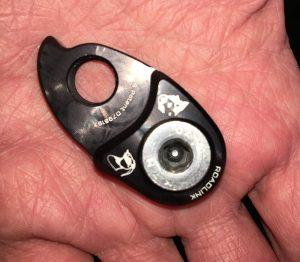 a 32T. After this, the only option was to run a mountain bike rear derailleur, but the smallest large cassette cogs these MTB rear derailleurs handle is 40T. So, what if you wanted to run a 34T or 36T? Along came the RoadLink.
a 32T. After this, the only option was to run a mountain bike rear derailleur, but the smallest large cassette cogs these MTB rear derailleurs handle is 40T. So, what if you wanted to run a 34T or 36T? Along came the RoadLink.
RoadLink is basically a rear dropout extender. Allowing you to run wider range of cassettes. Currently the RoadLink is built for Shimano 10 and 11 speed road rear derailleurs. The RoadLink is optimized for 11-36T (25T difference) and 11-40T (29T difference).
SIMPLE INSTALLATION
See photos below for actual installation (click image for larger view). Installation is a very simple task taking less than 5-minutes. To make this installation as easy as possible, before starting, I shifted the rear derailleur to the smallest cog which gave plenty of slack on the chain. If your chain is still tight, pop the chain off the front chainrings which allows maximum slack.
PHOTO A, I am using a 5mm hex wrench to loosen the hex bolt which removes the rear derailleur from the derailleur hanger.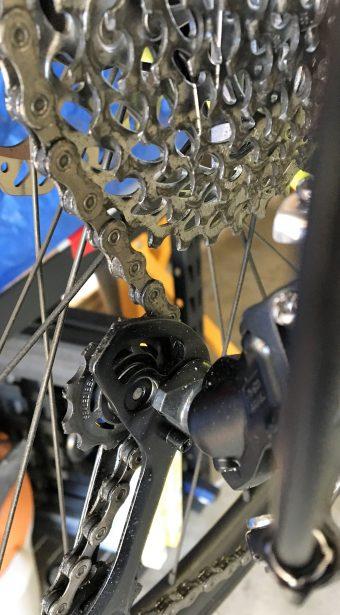
PHOTO B shows the rear derailleur removed. Note, the chain is still installed onto the drivetrain.
PHOTO C shows the installation of the RoadLink. I am using the same 5mm hex wrench as before, this time installing the RoadLink onto the rear derailleur hanger.
PHOTO D, I am reinstalling the rear derailleur into the lower threaded hole of the RoadLink. Warning, when installing a rear derailleur, make sure that the B-screw clears the tab. Accomplish by tilting the rear derailleur clockwise while tightening the rear derailleur attachment bolt.
PHOTO E – Job well done! Now, just run the drivetrain through the gears, making a small tweak here and there to make the shifting perfect.
In the PHOTO to the right, look how much additional space was achieved between the derailleur and cassette. Actually a little too much, time to back off on the B-limit screw adjustment.
OUT ON THE ROAD
As stated earlier, without the RoadLink, the derailleur wanted to either shift in the larger gears or smaller gears, but not all of the gears. Adding the ROTOR shim and RoadLink, the rear derailleur shifts perfect in every gear. No rubbing, clinking or clanking trying to find a gear.
I’ve used the RoadLink with the fore-mentioned configuration for several months now. I got out on a couple of hammer rides where I was mainly in the 52/11-15, but mostly the Haute Hills of San Clemente, CA. Our hill route picks hills of no less than 13% grade and peaking at 17.5% grade. For these rides, I’m in the 34/28-36 on the way up and 52/11-13 on the route down. This gives me a lot of shifting each ride and the bike performs flawlessly!
CAVEATS FROM THE ROADLINK TECH PAGE
• Double chainrings are only supported with GS (medium cage) rear derailleurs. You may need to change the front gearing so the rear derailleurs capacity is not exceeded.
• The RoadLink™ mounts only to standard derailleur hangers.
• The RoadLink™ is optimized for the 10 and 11 speed Shimano road derailleur geometry. It also works very well with 9 speed road groups, all SRAM groups, and Campy derailleurs. (Note: Campy works best with cassettes up to 11-36.
• SRAMs Exact Actuation road shifters (10s and 11s) are interchangeable with their Exact Actuation mountain derailleurs- which can easily handle a 36 or 40 (and, for one-by, are available with a clutch)- and the CX1 will go even bigger with a single ring.
• Triple chainrings are not supported (medium cage rear derailleurs cannot accommodate that big of a range).
• Direct Mount-native frames are not supported.
• Due to the lack of a clutch mechanism on Shimano road derailleurs, secondary chain retention (front derailleur or chain device) may be needed, especially for rough or off-road use.
• Due to variations in derailleur hanger geometry, chainstay length, chainring size, B-screw adjustment, and suspension configuration should all be adjusted accordingly.
• This 7.9mm max dimension is controlled by the Shimano spec, but a few derailleur hangers don’t meet the spec. Just file a little bit off the bottom “tang” of those derailleur hangers to install the RoadLink™.
• And, you will more than likely need to replace your current chain with a longer one (add several more links).
SUMMARY
I have to rate this a full 5/5 stars. The design is as simple as can be, no moving parts to break and it works! Period! At this price it’s the cheapest and best solution for adding some gearing to your road bike.

I have always enjoyed bicycling and, through a series of coincidences, became a Bicycle Industry Consultant and Product Tester. I test prototype products for companies and have published only off the shelf production products on biketestreviews.com.

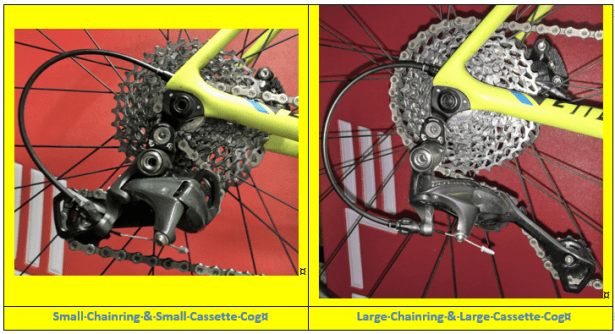

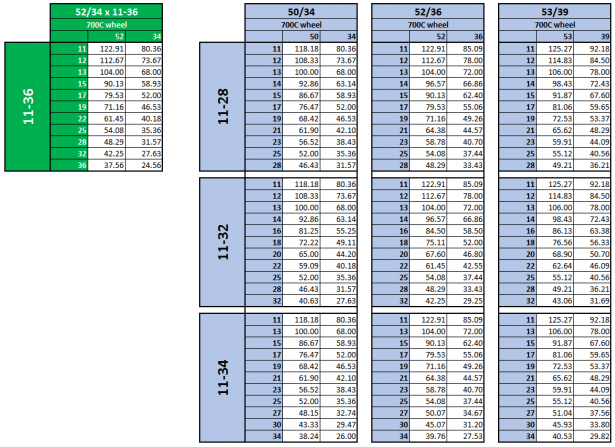
 thick at the top x 1.4mm thick at the bottom. It’s placed between the front
thick at the top x 1.4mm thick at the bottom. It’s placed between the front 
